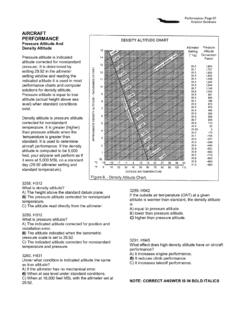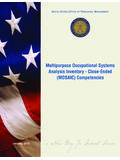Transcription of AERODYNAMICS AND AIRCRAFT OPERATIONS
1 AERODYNAMICS - Page 28 Aviation Seminars AERODYNAMICS AND AIRCRAFT OPERATIONS Definitions Angle of attack is the angle between the wing chord line and the direction of the relative wind. It changes as your flight path changes. Chord line is the line between the leading and the trailing edge of the airfoil. Relative wind is the direction of the airflow with respect to the wing. It is also the direction opposite and parallel to the flight path. Forces Acting On The AIRCRAFT Lift is the difference in pressure between the upper (lower pressure) and lower (higher pressure area) wing surfaces. Drag is the rearward force of wind resistance. Thrust is the forward acting force, produced by the propeller. Lift equals weight whenever you are in straight and level Forces Acting On The AIRCRAFT (Cont) flight, or climbing or descending at a constant rate (un-accelerated flight).
2 Thrust is equal to drag whenever your airspeed is constant. Angle Of Attack And Stalling Speeds An airplane can be stalled at any airspeed and in any flight attitude. The angle of attack at which an airplane stalls will always remain the same. An airplane will spin only after having been stalled. During a spin to the left, both wings remain stalled, but the right wing is less stalled than the left wing. Load Factor Load factor is the actual load on the wings at any time divided by the weight of the airplane. Increased Load factor in turns, for example, will cause an airplane to stall at a higher airspeed. The amount of excess load that can be imposed on the wing of an airplane depends upon the speed of the airplane. Functions Of The Flight Controls Ailerons roll the airplane about the longitudinal axis to change the bank.
3 The airplane turns because of the horizontal component of lift. Elevators pitch the airplane about the lateral axis to change the angle of attack. AERODYNAMICS - Page 29 Aviation Seminars Flight Controls (Cont) Rudder controls yaw about the vertical axis, not to turn the airplane, but to overcome adverse yaw produced by the depressed aileron on the high wing. Wing flaps increase drag to increase the angle of descent and allow steeper approaches to a landing without increasing airspeed. The most dangerous wind while taxiing in a nose-wheel equipped airplane is a quartering tailwind. Air Density High temperatures, high elevations, high humidity, and low atmospheric pressure all result in lower air density and decreased performance.
4 Air that is less dense (higher density altitude) will give you less performance because: - the wings produce less lift; - the engine produces less power; - the propeller exerts less force. Regardless of altitude and air density, the indicated airspeed at which an airplane stalls and your indicated speed on landing approach will remain the same. Ground Effect Ground effect is the result of interference of the earth with airflow patterns about an airplane, and will be realized when you are less than the wingspan above the surface. It causes a decrease in induced drag. Ground effect allows you to become airborne before reaching recommended takeoff speed. Any excess speed on landing may cause considerable floating. Stability Longitudinal stability (the nose pitching up or down) is determined by location of the center of gravity with respect to the center of lift.
5 An airplane said to be inherently stable will require less effort to control. An airplane (except T-tail) will pitch nosedown when power is reduced because the downwash on the elevator from the propeller slipstream is reduced and elevator effectiveness is reduced. AIRCRAFT AND ENGINE OPERATION P Factor And Torque At high angles of attack, the descending propeller blade has a greater angle of attack than the ascending blade, thus it pulls more and yaws the airplane to the left. The most torque and P-factor are experienced at high angles of attack, high power settings, and low airspeeds. Engine Operation The first action after starting an AIRCRAFT engine should be to adjust for proper RPM and check for desired indications on the engine gauges.
6 When starting an engine by hand, have a competent pilot at the controls in the cockpit. Dual ignition, in addition to providing an increased safety factor, also provides improved engine performance. A constant speed propeller permits the pilot to select the blade angle for the most efficient performance. The throttle controls power output as registered on the manifold pressure gauge and the propeller control regulates blade angle to provide a constant RPM. Avoid high manifold pressure setting with low RPM. Engine cooling is caused by airflow and is especially dependent on the circulation of lubricating oil. Overheating can be caused by: - lower than specified fuel octane/rating, -too high power setting, - climbing at an excessive rate of climb and insufficient airspeed, - mixture set too lean, and - oil level being too low; AERODYNAMICS - Page 30 Aviation Seminars Engine Operation (Cont) Higher temperatures will cause loss of power, excessive oil consumption and possible engine damage.
7 Detonation occurs when the unburned charge (fuel) in the cylinders explodes instead of burning evenly. If you suspect that the engine is detonating during climb-out, lower the nose to increase airspeed. Preignition is the uncontrolled firing of the fuel/air charge in advance of normal spark ignition. While at a high altitude airport and while checking your magnetos, if you notice a roughness in the engine that gets worse when you check carburetor heat, check the results obtained with a leaner mixture setting. Fuel Use the correct octane of fuel specified for your AIRCRAFT . If the correct octane is not available, a higher octane will not be harmful unless used for a long time. Make sure there is no water or contamination in the fuel by: - draining the fuel sumps and the fuel strainer before each flight, and - filling the tanks after completion of a flight to minimize the possibility of condensation of water on the inner walls of partially filled tanks.
8 Do not run the fuel tanks dry because the engine-driven fuel pump or electric fuel boost pump may draw air into the fuel system and cause vapor lock. Float-type carburetor operation is based on the difference in air pressure at the venturi throat and the air inlet. Fuel (Cont) The main purpose of the fuel/air mixture control is to decrease the fuel flow to compensate for decreased air density at higher altitudes. As you climb out to a higher altitude, if no adjustment is made to the mixture, your mixture will become richer. Induction Icing Carburetor icing is caused by sudden cooling of the air as it expands in the venturi of the carburetor. Carburetor icing will most likely occur with temperatures between 20 and 70 degrees F with high relative humidity.
9 Carb ice reduces the amount of air coming into the carburetor. The indication for an airplane with fixed pitch propeller is the loss of RPM. When you apply carb heat there will be a drop in RPM. If there is no carb ice, the RPM will remain there. If carb ice is present when you apply carb heat, the RPM will drop then rise as the ice melts. Carburetor heat reduces the density of the air by heating it, and this makes the mixture richer. It decreases engine output and increases operating temperatures. Float-type carburetor systems, in comparison to fuel injection systems are considered to be more susceptible to evaporative icing. Emergencies And Miscellaneous Information Perform a walk-around inspection of the AIRCRAFT before each flight.
10 Use a written checklist to ensure that all items are checked in a logical sequence. If an AIRCRAFT has been stored an extended period of time, check for damage or obstructions caused by animals, birds or insects. If you lose power immediately after takeoff, immediately establish the proper gliding attitude and airspeed. 3201. H911 The four forces acting on an airplane in flight are A) lift, weight, thrust, and drag. B) lift, weight, gravity, and thrust. C) lift, gravity, power, and friction. NOTE: CORRECT ANSWER IS IN BOLD ITALIC AERODYNAMICS - Page 31 Aviation Seminars 3202. H911 When are the four forces that act on an airplane in equilibrium? A) During unaccelerated flight. B) When the AIRCRAFT is accelerating. C) When the AIRCRAFT is at rest on the ground.



